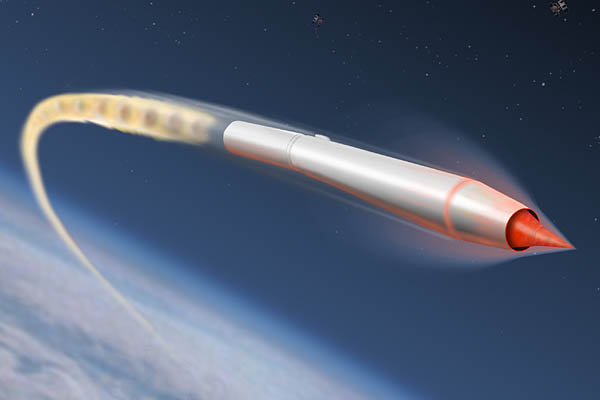
Fasthawk Cruise Missile:
| In the first decade of the 21th century it became clear that, although
having served well, the Tomahawk cruise missile needed a replacement. Even
with the upgrade of the basic missile to the TacTom configuration (Tactical Tomahawk)
the missile was becoming obsolete. With its slow speed and reaction time
the Tomahawk became an increasingly easy target for defense systems, and in a modern
war it simply couldn`t be launched fast enough (requiring extensive planning to program
its flightpath). The new missile would have to be much more flexible, and be capable of reaching
its target much faster.
Enter the Fasthawk, the product of almost a decade of work by the Boeing corporation. Just like the Tomahawk it replaced the Fasthawk was designed to fit into the existing Strategic-length MK-41 vertical launch system. The missile as taken into production was a hypersonic missile powered by a airbreathing ramjet. Since the missile moved at extreme velocity there was no need for wings: the round body supplied all the lift that was needed to keep the missile airborne. Steering was done by means of a movable nozzle, which made up the entire tail of the Fasthawk. Guidance and flightpath were dependant upon the chosen mission. For ground strikes the
Fasthawk would usually follow a very high flight profile, nearly that of a ballistic missile.
This enabled the missile to reach extreme speeds, and in its terminal phase the missile dived
almost vertically down upon its target. The missile can be fired ballistic at Naval targets
but usually is fired in the surface skimming path. For anti ship purposes the missile normally
follows a surface skimming attack profile but can follw this path against ground targets as
well. Since in this mode of flight the missile encounters a great deal of air resistance both
range and speed were markedly decreased from the ground strike flight path.
The choise of warheads was somewhat limited when compared to the old Tomahawk missile,
with only three options available. The most common of these was a general purpose blast-fragmentation
warhead which could be optimalized for several different burst modes. The first was Airburst, for for destroying
vehicles, light material and troops. In this setting the warhead would explode a few dozen feet above
the targets, spraying them with (preforged armor penetrating) fragments. The second burst mode was contact burst,
which was normally used in the anti ship mode. In this setting the warhead exploded on impact. The final
setting was delayed contact burst, in which the incredible kinetic energy of the missile (moving at mach 5+) was
used to penetrate deeply into hardened targets like bunkers. Up to a hundred feet of sand or nearly thirty feet of
hardened concrete could be penetrated before the warhead exploded.
The Fasthawk is a Smart missile with +5 to strike and +3 to dodge. |
| Warhead | Mega-Damage | Blast Radius |
| Blast Fragmentation (Airburst) | 3D4x10 | 180 ft (54 m) |
| Blast Fragmentation (Contact) | 6D6x10 | 50 ft (15.2 m) |
| [1]Blast Fragmentation (Delayed Contact) | 1D4x100 | 30 ft (9.1 m) |
| Fusion (Medium) | 1D4x100 | 100 ft (30.3 m) |
| Fusion (heavy) | 2D4x100 | 120ft (36.4 m) |
| [1] warhead will penetrate the armor if the damage done equals or exceeds 30% of the (remaining) armor of the area being attacked. If the warhead penetrates, all targets inside, including equipment, take one-third inflicted damage. Note that locations such as magazines and engineering are often behind additional armor. |
| M.D.C.: | 40 |
| Missile Speed (Ballistic Flight): | 3,031 knots (3,500 mph / 5,614 kph). |
| Missile Speed (Surface Skimming): | 1,602 knots (1,850 mph / 2,967 kph). |
| Maximum Effective Range: | 400 nautical miles (462 miles / 741 km) when used in Surface Skimming mode and 1,200 nautical miles (1,381.2 miles / 2,215 km) when fired in Ballistic Flight Mode. |
| Weight: | 4,757 lbs. (2,150 kg). |
| Missile Length: | 21 ft. 4 in (6.4 m). |
| Missile Diameter: | 20.4 in (51.81 cm). |
| Missile Cost: | 360,000 (Blast Fragmentation warhead) / 440,000 (Medium Fusion) / 500,000 (Heavy Fusion). |
[ Rifts® is a registered trademark owned by Kevin Siembieda and Palladium Books Inc.]
By Mischa (E-Mail Mischa ).
Copyright © 2001, Mischa. All rights reserved.